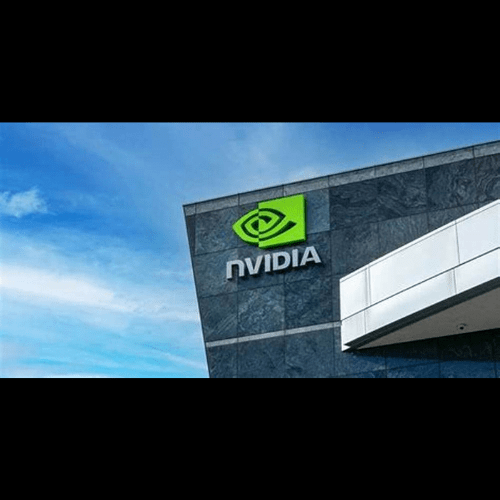Introduction: The Shift in the Dow Jones Industrial Average
Recently, NVIDIA (NVDA) replaced Intel (INTC) on the Dow Jones Industrial Average (DJIA), marking a significant milestone for both companies and the semiconductor industry. NVIDIA’s rapid ascent reflects its dominance in the AI and data center markets, where demand for high-performance graphics processing units (GPUs) is surging. This replacement also underscores Intel’s struggle to regain its footing amid fierce competition in an industry reshaped by AI and cloud computing. The inclusion of NVIDIA in the Dow could lead to notable changes in each company’s stock, as well as broader implications for investors and market dynamics.
1. NVIDIA’s Immediate Stock Implications
NVIDIA’s entry into the Dow may support its short-term stock performance. The DJIA is a price-weighted index, meaning that high-priced stocks like NVIDIA have a greater influence on the index’s movement. Institutional funds that track the Dow will now be buying NVDA shares to reflect this change, potentially creating upward pressure on its price. Additionally, inclusion in the Dow provides added visibility and perceived stability, enhancing its attractiveness to both retail and institutional investors. The anticipated growth trajectory for AI-related revenue could further support its valuation, which has already grown over 180% this year, driven by NVIDIA’s innovations and strong sales in the data center and gaming sectors.
In the near term, this inclusion could help NVIDIA weather market volatility. The company’s unique positioning in the AI market has set it apart as a tech powerhouse with a competitive advantage. Investors see NVIDIA as a “growth blue-chip,” as it offers high growth potential while benefiting from the stability associated with Dow membership. This narrative of stability and growth could help sustain investor interest, even if market-wide tech valuations face pressure due to economic factors such as rising interest rates.
2. Potential Risks and Overvaluation Concerns for NVIDIA
While NVIDIA’s stock is bolstered by strong AI demand, its high valuation raises questions about long-term sustainability. The company’s price-to-earnings ratio is significantly higher than the tech industry average, reflecting high expectations for its future performance. This could make the stock vulnerable to sharp corrections if growth in AI or data center demand slows unexpectedly, or if a broader market correction impacts tech stocks. However, as NVIDIA continues to solidify its role as a critical supplier to cloud and AI-driven businesses, its high valuation could remain supported as investors continue to value growth potential and innovation leadership.
3. Intel’s Immediate Stock Implications
Intel’s removal from the Dow carries reputational consequences and may signal to investors that its growth prospects are limited compared to peers. Dow delistings often lead to reduced visibility, potentially affecting investor sentiment and lowering the stock’s appeal to long-term investors seeking stable, index-backed growth. Some investment funds that mimic the Dow’s composition will likely divest from Intel, potentially causing short-term downward pressure on the stock.
In the near term, Intel faces pressure to accelerate its turnaround strategy, particularly in data center and AI markets. CEO Pat Gelsinger has laid out plans to rejuvenate Intel’s technological and manufacturing capabilities, including multi-billion-dollar investments in U.S. semiconductor manufacturing. Despite this, Intel remains in a challenging position as it competes with NVIDIA, Advanced Micro Devices (AMD), and Taiwan Semiconductor Manufacturing Company (TSMC), all of which lead in high-performance computing chips essential for AI and cloud applications. If Intel can execute its turnaround plan effectively, it may mitigate some of the reputational damage from its Dow removal.
4. Strategic Implications for Both Companies
NVIDIA’s Dow entry is symbolic of the industry’s shift toward AI and high-performance computing, where NVIDIA has emerged as a critical enabler for AI advancements. NVIDIA’s close partnerships with cloud giants like Google, Amazon, and Microsoft emphasize its role as a hardware backbone for AI operations. These dynamics could lead to a strong alignment between NVIDIA’s stock performance and broader AI investment trends, reinforcing its appeal to investors focused on next-gen technologies.
For Intel, the exclusion serves as a wake-up call to refocus on innovation and address market expectations. The company has undertaken restructuring efforts, such as divesting from low-margin businesses and investing in chip manufacturing to compete with TSMC and Samsung. However, the success of these initiatives will be critical to restoring investor confidence. Intel’s AI and data center market share is increasingly under threat, and its ability to regain relevance in these areas will likely be a key determinant of future stock performance.
5. Broader Market Impact and Industry Implications
The replacement of Intel with NVIDIA reflects a broader trend of tech transformation within traditional market indices. As AI and data center growth reshape the tech industry, market indices like the Dow are adjusting to capture this shift. This replacement also highlights investor appetite for exposure to AI, which could increase interest in other companies that enable AI technologies, such as cloud service providers, data analytics firms, and even firms developing AI infrastructure software.
Additionally, NVIDIA’s inclusion could prompt similar adjustments within other indices, reflecting a broader trend of weighting innovative tech companies higher than legacy tech firms. This trend is noteworthy for sector-focused ETFs and mutual funds, which may reallocate holdings to include NVIDIA and other AI-driven companies, potentially leading to a reevaluation of semiconductor and technology sector allocations.
Conclusion: Future Outlook for NVIDIA and Intel
NVIDIA’s inclusion in the Dow may fuel near-term stock gains as new capital flows in, driven by institutional buying and increased visibility among retail investors. However, the stock’s high valuation poses risks, especially in a volatile tech market environment. NVIDIA’s challenge will be to sustain its growth trajectory in a rapidly evolving AI landscape.
For Intel, Dow exclusion represents both a setback and an opportunity. While short-term pressures could impact its stock negatively, the company’s future success will depend on its ability to execute on its turnaround strategy and reclaim market relevance. By emphasizing innovation, Intel could appeal to investors who prioritize value and potential growth, especially if its manufacturing initiatives yield results.
As the semiconductor industry continues to evolve, NVIDIA’s rise and Intel’s struggle serve as reminders of the rapid shifts taking place in tech. Investors will likely monitor both companies closely to assess their roles in the future of AI and computing, with NVIDIA positioned as a frontrunner and Intel working to reestablish its legacy in a competitive market. The coming months will reveal how each company adapts to these changes, with significant implications for their respective stock performances.
by Steve Macalbry
Senior Editor,
BestGrowthStocks.Com
Disclaimer: The author of this article is not a licensed financial advisor. This article is intended for informational purposes only. It should not be considered financial or investment advice. We have not been compensated for the creation or distribution of this article and we do not hold any form of equity in the securities mentioned in this article. Always consult with a certified financial professional before making any financial decisions. Growth stocks carry a high degree of risk, and you could lose your entire investment.






